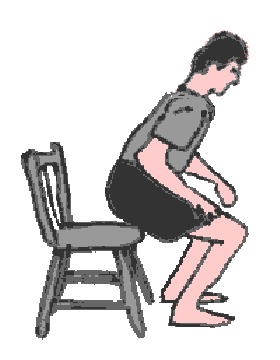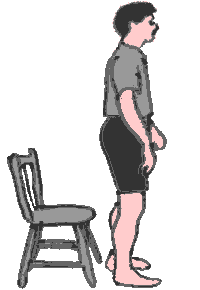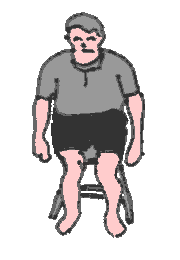|
|
|---|
The sit to stand movement:- Start Position
- Start by sitting in a comfortable dining room chair with your back supported.
- With the help of your hands, ease yourself forward to the edge of the chair.
- Imagine that there is a buoyancy balloon in your head located above and between your ears.
Let the balloon elongate your neck away from you shoulders. Feel the back of your neck elongate
& your chin tuck slightly.
- Scapulas anchored, pelvic neutral and spine elongating.
The sit to stand movement:- Action
Important: Let your legs do the movement! Your pelvis maintains neutral, and
your spine elongates throughout.
- Breathe in and zip and hollow. Bend forward at the hips, and feel
your weight come over your feet. Hold this position. Your feet are now supporting most of your weight.
- Engage your Gluteus maximus muscles, and think "head buoyant".
- (Breathing out): Push upward from your heals.
- You are now standing!
- Repeat four to 10 times. (And indeed every time you stand up through the day!)
(Scroll right>>>>....)
|
The sit to stand movement:-
|
|
Start Position
|
Action
|
Finnish
|


|


|


|
Comments
- Perform this exercise every time you get out of a chair! It not only protects the entire length of
your spine, it also moves your hip joints the way they did before chair sitting
was invented.
- Engaging the Gluteus maximus is important to the success of this exercise,
because the Gluteus maximus is weak in modern man, and this
weakness contributes to his "bad back"(3).
|
Do not let your knees
collapse inwards:-

|
|
What it does
- Keeps the spine from your pelvis to your skull well within its safe middle positioning(1,2).
- Encourages your hips to move the way they did before chair sitting
was invented.
- Gets your lazy Gluteus maximus working.
Watch Points
- Your spine maintains its length. Do not change its shape!
- In order to maintain your "motionless" spine you will need to let your head
look down a little at the moment of pushing upward to the stand position, but don't
forget to think "head buoyant"!
- Do not let your knees
collapse inwards.
Reference
- B I Kodisch:
Back Pain Solutions: How to help Yourself with Posture-Movement Therapy and Education.
Extensional Publ. Pasadena, Ca 2001 ISBN 0-9700664-5-7
- Wilfred Barlow: "The Alexander Principle" Arrow Books Ltd. Reprinted 1987 ISBN 0 09 910160 2
- Bruce Thomson: Engage Gluteus maximus!
© Bruce Thomson, EasyVigour Project
(scroll up^^^^....)
|